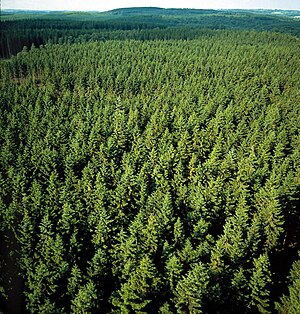Leiphofen: Difference between revisions
No edit summary |
No edit summary |
||
| Line 58: | Line 58: | ||
==Geography== | ==Geography== | ||
[[File:Pine forest in Sweden.jpg|thumb|upright=1.0|left|alt=Pine forest|Pine forests dominate the landscape of the islands.]] | [[File:Pine forest in Sweden.jpg|thumb|upright=1.0|left|alt=Pine forest|Pine forests dominate the landscape of the islands.]] | ||
Leiphofen-Scharnau and all constituent islands and islets within are located within the [[Süd Depths]]. Most of the islands are represented by forested hilly landscapes with jagged and rocky coasts. Almost all of the islands are covered by temperate coniferous rainforests, dominated by pine, spruce, fir and larch. Some portions of the islands are wetlands or meadows, especially near the numerous rivers. A number of areas of the grand duchy have been designated as regal preserves, protected natural areas for use of the regal family only. Along the rock-bound coasts are lighthouses, beaches, fishing villages, and thousands of offshore islands. There are jagged rocks and cliffs and many bays and inlets. Geologists describe this type of landscape as a "drowned coast", where a rising sea level has invaded former land features, creating bays out of valleys and islands out of mountain tops. | |||
There are a large number of wild animals present on the islands, with the most common being deer, coyotes, foxes, pine squirrels and beavers. | There are a large number of wild animals present on the islands, with the most common being deer, coyotes, foxes, pine squirrels and beavers. Leiphofen-Scharnau is home to a great number of birds including Golden Eagles, Cardinals, Bluebirds, and Westland Petrels. Many species of fish live in the ocean waters surrounding the islands, and the fishing industry is a major part of the economy, including commercial whaling. | ||
===Climate=== | ===Climate=== | ||
The climate of | The climate of Leiphofen-Scharnau is humid continental climate and a cool summer subtype. Surface water temperatures around the islands reach a summer average of 12 °C (54 °F) inshore and 9 °C (48 °F) offshore to winter lows of −1 °C (30 °F) inshore and 2 °C (36 °F) offshore. The sea keeps winter temperatures slightly higher and summer temperatures a little lower on the coast than inland. The maritime climate produces more variable weather, ample precipitation in a variety of forms, greater humidity, lower visibility, more clouds, less sunshine, and higher winds than a continental climate. Light to heavy fog is a common and near daily occurance on the islands. | ||
{{Multiple image | |||
| caption_align = center | |||
| total_width = 340 | |||
| image1 = 1843 portrait of Prince Francois of Orléans, Prince of Joinville by Winterhalter (Versailles)(2).jpg | |||
| caption1 = Grand Duke Leopold XIX | |||
| image2 = Жозефина Лейхтенбергская, королева Швеции и Норвегии.jpg | |||
| caption2 = Grand Duchess Melisenda | |||
}} | |||
Revision as of 00:14, 20 October 2022
This article is incomplete because it is pending further input from participants, or it is a work-in-progress by one author. Please comment on this article's talk page to share your input, comments and questions. Note: To contribute to this article, you may need to seek help from the author(s) of this page. |
Grand Duchy of Leiphofen-Scharnau | |
|---|---|
| Capital | Leiphofen |
| Largest city | Scharnau |
| Official languages | Scharnauer |
| Government | Monarchy |
• Grand Duke | Leopold XIX |
| Population | |
• Estimate | 49,699,000 |
| Currency | Leiphofen-Scharnauer Lev |
Leiphofen-Scharnau, officially the Grand Duchy of Leiphofen-Scharnau or the Grand Duchy of Leiphofen and Scharnau, is a sovereign state located within the Süd Depths. Located east of Hrastče and south of Hafodmark, Leiphofen-Scharnau enjoys a temperate climate, with a majority of the nation being covered in temperate rainforests and seperated by land cleared for agriculture.
Geography
Leiphofen-Scharnau and all constituent islands and islets within are located within the Süd Depths. Most of the islands are represented by forested hilly landscapes with jagged and rocky coasts. Almost all of the islands are covered by temperate coniferous rainforests, dominated by pine, spruce, fir and larch. Some portions of the islands are wetlands or meadows, especially near the numerous rivers. A number of areas of the grand duchy have been designated as regal preserves, protected natural areas for use of the regal family only. Along the rock-bound coasts are lighthouses, beaches, fishing villages, and thousands of offshore islands. There are jagged rocks and cliffs and many bays and inlets. Geologists describe this type of landscape as a "drowned coast", where a rising sea level has invaded former land features, creating bays out of valleys and islands out of mountain tops.
There are a large number of wild animals present on the islands, with the most common being deer, coyotes, foxes, pine squirrels and beavers. Leiphofen-Scharnau is home to a great number of birds including Golden Eagles, Cardinals, Bluebirds, and Westland Petrels. Many species of fish live in the ocean waters surrounding the islands, and the fishing industry is a major part of the economy, including commercial whaling.
Climate
The climate of Leiphofen-Scharnau is humid continental climate and a cool summer subtype. Surface water temperatures around the islands reach a summer average of 12 °C (54 °F) inshore and 9 °C (48 °F) offshore to winter lows of −1 °C (30 °F) inshore and 2 °C (36 °F) offshore. The sea keeps winter temperatures slightly higher and summer temperatures a little lower on the coast than inland. The maritime climate produces more variable weather, ample precipitation in a variety of forms, greater humidity, lower visibility, more clouds, less sunshine, and higher winds than a continental climate. Light to heavy fog is a common and near daily occurance on the islands.


